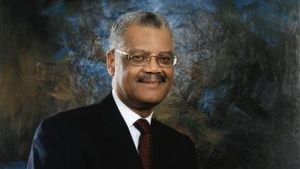Boom Supersonic, the American aviation company, made aviation history this week as its XB-1 aircraft achieved supersonic flight, becoming the first independently developed jet to break the sound barrier.
On January 28, 2025, at the Mojave Air & Space Port, XB-1 climbed to 35,290 feet before reaching speeds of Mach 1.122, or approximately 750 miles per hour, during its experimental flight. This monumental feat heralds the potential for the return of commercial supersonic travel, which has been absent since the Concorde's retirement more than two decades ago.
Led by Chief Test Pilot Tristan “Geppetto” Brandenburg, the flight marked the culmination of extensive development efforts by Boom Supersonic, founded by Blake Scholl. "XB-1's supersonic flight demonstrates the technology for passenger supersonic flight has arrived," Scholl commented, highlighting the achievement as a pivotal moment for the future of aviation.
The XB-1 is constructed primarily from advanced carbon fiber composites and features state-of-the-art technology, including augmented reality systems to aid with landing visibility. This innovative design is intended not only to push the boundaries of speed but also to address long-standing concerns about noise pollution associated with supersonic flights.
With aspirations to develop the Overture aircraft, which would carry 64-80 passengers at Mach 1.7 (about twice the speed of current subsonic jetliners), Boom has already amassed 130 orders and pre-orders, including commitments from major airlines such as American Airlines and United Airlines.
The historical importance of this achievement cannot be overstated; the Mojave Desert airspace where the XB-1 took flight holds a legacy tied to legendary pilot Chuck Yeager, who famously broke the sound barrier there in 1947.
Scholl reflects on this legacy as he outlines his vision for the future. “I very much believe in the return of supersonic air travel and to bring it to every passenger on every route,” he noted. This ambition seeks to make flight times dramatically shorter—imagine flying from New York to Shanghai in under 40 minutes.
While the excitement surrounding the XB-1 is palpable, the path to widespread commercial use may not be straightforward. Supersonic jets still face obstacles such as regulatory approval for commercial routes over land due to sonic boom concerns. The legacy of the Concorde, which was limited drastically by such regulations, serves as both inspiration and cautionary tale for Boom Supersonic.
Apart from the technical and regulatory challenges, fuel efficiency and environmental impact remain key areas of focus for Boom Supersonic. The Overture airline is expected to be powered by engines capable of running on sustainable aviation fuel (SAF), aligning with the industry's aims to reduce carbon emissions and environmental footprints.
Construction on Boom’s Overture Superfactory, located in Greensboro, North Carolina, stands as evidence of their belief in the future of supersonic travel. Once operational, the facility is expected to produce up to 66 Overture aircraft annually, making the dream of widespread supersonic travel ever closer to reality.
Looking forward, the implementation of digital engineering techniques has allowed Boom to simulate designs with efficiency far exceeding the physical model testing methods used during the Concorde's development. This evolution signifies not just the technical advancements possible today, but also opportunities to innovate within aviation as Old World challenges are addressed with New World solutions.
It is clear from the successful test flight of the XB-1 and the promising plans for the Overture airliner, the return of supersonic travel is becoming more than just a dream. With continued focus on technology, efficiency, and environmental sustainability, Boom Supersonic stands poised to redefine passenger travel standards for the 21st century.



